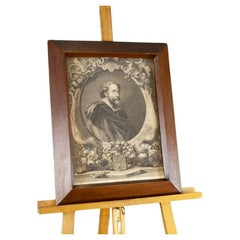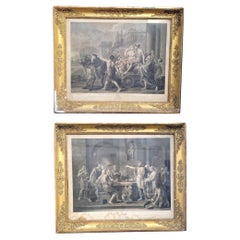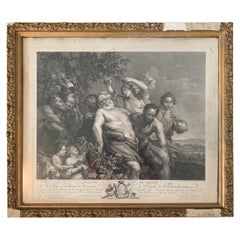Anthony Van Dyck Wall Decorations
Flemish, 1599-1641
A three-quarter length portrait of Anne, Lady Russell, later Countess of, Attributed to Sir Anthony Van Dyck.
Anne Carr, Lady Russell, an esteemed beauty was clearly a favourite of Sir Anthony Van Dyck. There are six portrait types of Lady Russell listed in Miller, et al. It is tempting to associate the current portrait with the three-quarter length in blue in the Egremont collection at Petworth House (Millar IV.22) because of the similarity of colouring. However, we believe that this picture represents a different portrait type, and most likely derives from a separate sitting. The comparison with the short three-quarter length belonging to the Tokyo Fuji Art Museum, Tokyo (Millar IV.23), is telling. The heads are essentially the same, though the pose and the colouring of the portraits are quite different. The Japanese painting features a rose-red gown and a fawn stole, possibly darker than in this painting. This comparison also illustrates Van Dyck's ability to develop different compositions from a single sitting.
Dr. Malcolm Rogers CBE FSA believes this painting to be an unfinished work by the artist:
"with, as you might expect, preparatory work by a member of his studio. Especially encouraging is the penumbra of thicker paint around the lady's head which is a recognised feature associated with the artist's ad vivum rendering of heads. My notes do not mention a similar penumbra in the Tokyo painting, though the painting is throughout of very high quality. There are one or two slight pentimenti in the silhouette of the figure of your painting and in the line of her stole, which at one point may have been intended to run over her right wrist. Close examination may reveal more. Some areas of the draperies, especially the linens are not fully realised, and, of course, the background is only roughed in.
Millar suggests that the Tokyo painting with its loose gown and protective hands may indicate that the sitter is pregnant. The gown is similarly loose in [this] painting. If she is indeed pregnant this might suggest a date around 1638 or 1639, in which years the first two of her eleven children were born. I cannot explain why the painting was left unfinished, but it is, must be, a distinct possibility that this is the very portrait of Lady Bedford that remained in Van Dyck's studio at the time of his death (see C. Brown and N. Ramsay, 'Van Dyck's Collection: Some New Documents', Burlington Magazine, Vol. 132, pp. 704-9)."
Dimensions: 53 1⁄8 in (H) x 43 1⁄4 in (W)
Provenance: Picture probably listed in contents of van Dyck’s studio at time of death December 1641 (O. Millar, Van Dyck, A complete catalogue of the paintings, New Haven and London, 2004, under no. IV.23);
The most Reverand Dean of Durham, possibly William Lake (1817-1897);
Charles Sedelmeyer, 1906, as 'Sir Anthony van Dyck';
Colonel Edward F Simms of Kentucky;
H. Kenneth Franzheim;
Kenneth Franzheim II;
Thence by descent to Sabrina Franzheim (current owner).to
1
1
Height
to
Width
to
1
1
1
1
1
1
1
4
436
301
286
282
Creator: Anthony Van Dyck
Early 18th-Century Portrait of Rubens After Anthony Van Dyck - Engraving
By Anthony van Dyck
Located in Opole, PL
Early 18th-Century Portrait of Rubens After Anthony Van Dyck - Engraving in wooden frame
A portrait of Rubens based on Anthony Van Dyck (1599–1641), a copperplate engraving from the...
Category
Early 18th Century Belgian Antique Anthony Van Dyck Wall Decorations
Materials
Paper
Related Items
Pair of Framed Neoclassical Engravings, Late 18th Early 19th century
Located in MARSEILLE, FR
Pair of framed neoclassical engravings, after works painted by Jean Jacques François Le Barbier (1738 - 1826) and engraved by Jean-Jacques Avril (1744-1831), dated 1789 for the paint...
Category
Late 18th Century French Neoclassical Antique Anthony Van Dyck Wall Decorations
Materials
Wood, Paper
$2,912 / set
H 29.14 in W 34.65 in D 1.97 in
Pierre Paul Rubens « Silène’s Walk », Engraving 18th Century
Located in Beuzevillette, FR
Beautiful engraving made by Nicolas de Launay after the work of Peter Paul Rubens.This engraving represents a bacchanalian scene featuring Silenus a mythological character.
In this...
Category
18th Century French Antique Anthony Van Dyck Wall Decorations
Materials
Paper
Aeneid After Mitelli And Caracci, Framed Engravings, 18th Century
By Giuseppe Maria Mitelli
Located in MARSEILLE, FR
Suite of 5 framed engravings recounting episodes from the Aeneid, journey of the hero Aeneas after the fall of Troy, according to Virgil
* "Ecce trahunt manibus victum post terga si...
Category
18th Century Italian Greco Roman Antique Anthony Van Dyck Wall Decorations
Materials
Paper
$2,330 / set
H 17.72 in W 27.37 in D 0.6 in
18th Century Carlo Lasinio Hand Coloured Portrait Engravings - Set of 18
By Carlo Lasinio
Located in Los Angeles, CA
Set of 18 hand colored copper engravings done by Carlo Lasinio depicting notable artists and scholars with captions pasted beneath, within frame of printed borderlines.
The engravin...
Category
18th Century Italian Baroque Antique Anthony Van Dyck Wall Decorations
Materials
Glass, Paper, Walnut
$4,400
H 15.5 in W 11.25 in D 0.75 in
Set of Twelve 18th Century Zoological Engravings
Located in Shipston-On-Stour, GB
A rare 18th Century set of 12 handcoloured copperplate engravings of Zoological studies, featuring primates of varying species. Each colourfully executed with a naive charm, and Lati...
Category
1770s German Other Antique Anthony Van Dyck Wall Decorations
Materials
Glass, Wood, Paint, Paper
Framed 18th Century Neoclassical Style Portrait Engravings, Set of 4
Located in Elkhart, IN
A lovely set of four 18th century style portrait engravings with allegorical scenes presented in giltwood frames under glass with very fine hand-colored matting. The engravings were ...
Category
Late 20th Century American Neoclassical Anthony Van Dyck Wall Decorations
Materials
Glass, Giltwood, Paper
$1,516 Sale Price / set
20% Off
H 26 in W 19 in D 1 in
The Three Ages Of Man Flemish Baroque Oil Painting After Anthony van Dyck 48"
By Anthony van Dyck
Located in Dayton, OH
A large antiqued reproduction oil painting after Anthony Van Dyck. Aptly titled "The Three Ages of Man" Features an antiqued canvas with unique craquelure and Baroque scalloped fra...
Category
Late 20th Century Baroque Anthony Van Dyck Wall Decorations
Materials
Canvas, Paint
$940 Sale Price
20% Off
H 48 in W 36 in D 3 in
Set of 9, 18th Century Italian Engravings Feature the Portrait of Female Statue
By Giovanni Domenico Campiglia
Located in Los Angeles, CA
These Beautiful Italian 18th Century Black & White Engravings on Laid Paper Feature the Portrait of Female Statues, these pieces has been professionally Framed using all new Material...
Category
18th Century Italian Renaissance Antique Anthony Van Dyck Wall Decorations
Materials
Paper, Textile, Linen, Wood, Paint
$11,284 / set
H 20.5 in W 15 in D 2 in
Framed Set of 18th Century Classical Engravings
Located in Pembroke, MA
Two French matted and framed 18th century black and white engravings inspired by Classical Antiquity. The first frame contains an engraving of a woman patting a unicorn, and a man an...
Category
18th Century French Classical Greek Antique Anthony Van Dyck Wall Decorations
Materials
Giltwood, Paper
$3,500 Sale Price / set
20% Off
H 32.5 in W 23 in D 1.25 in
18th-19th Century Old Master "The Holy Family" After Anthonius van Dyck
By Anthony van Dyck
Located in San Francisco, CA
18th-19th century Old Master "The Holy Family" After Anthonius van Dyck
Fine old master painting depicting The Holy Family after a painting by Flemish artist van Dyck.
Original...
Category
Early 19th Century Danish Other Antique Anthony Van Dyck Wall Decorations
Materials
Canvas
$4,500
H 25.5 in W 23.5 in D 3 in
18th Century Pair of English Engravings
Located in Dallas, TX
Superb pair of 18th century English engravings.
Category
18th Century English Antique Anthony Van Dyck Wall Decorations
The Children of Charles I, After Sir Anthony Van Dyck
Located in London, GB
Engraving depicting The Children of Charles I (1600-49), After the 1637 portrait by Sir Anthony Van Dyck (1599-1641).
18th century, English ...
Category
18th Century English Renaissance Antique Anthony Van Dyck Wall Decorations
Materials
Paper
Anthony Van Dyck wall decorations for sale on 1stDibs.
Anthony Van Dyck wall decorations are available for sale on 1stDibs.
Creators Similar to Anthony Van Dyck
Questions About Anthony Van Dyck Wall Decorations
- 1stDibs ExpertOctober 30, 2024How much a van Dyck painting is worth varies based on its historical significance, condition and size. At a London auction in 2009, a self-portrait of the artist sold for $13.5 million. Sir Anthony van Dyck was a Flemish Baroque artist who became the leading court painter for Charles I of England. He is best known for his portraits of royalty and aristocracy, most notably Charles I and his family and associates. His style changed considerably between the countries he worked in, culminating in the relaxed elegance of his last English period. Van Dyck widely influenced English portrait painting for the next 150 years, and his influence extended into the modern period. If you own a van Dyck piece, use the services of a certified appraiser or knowledgeable art dealer to learn how much it may be worth. On 1stDibs, find a variety of Baroque art.


